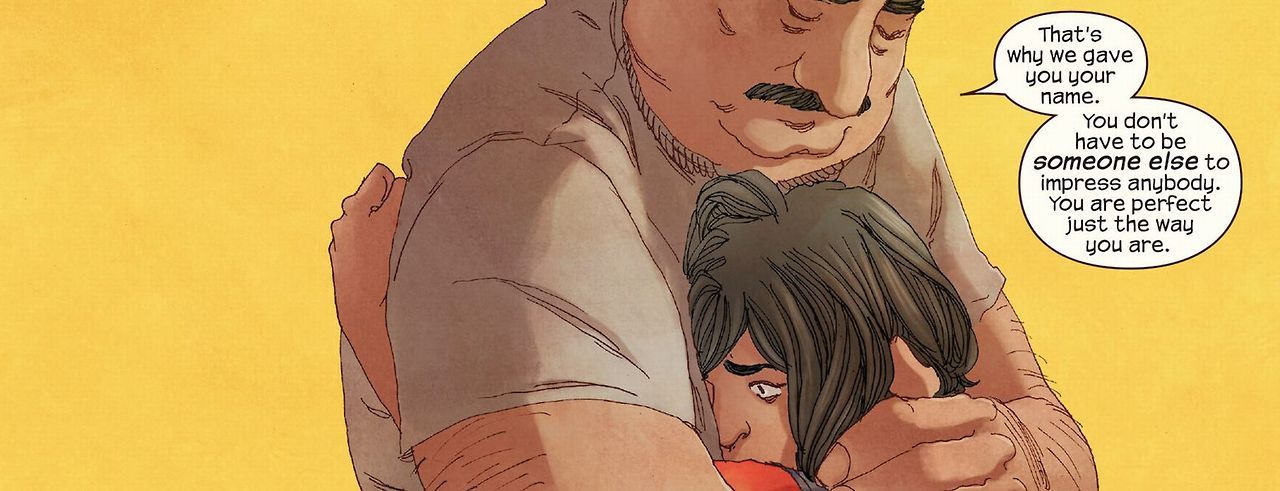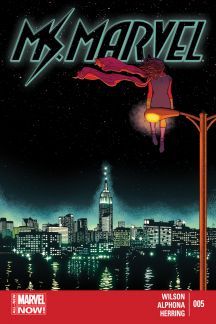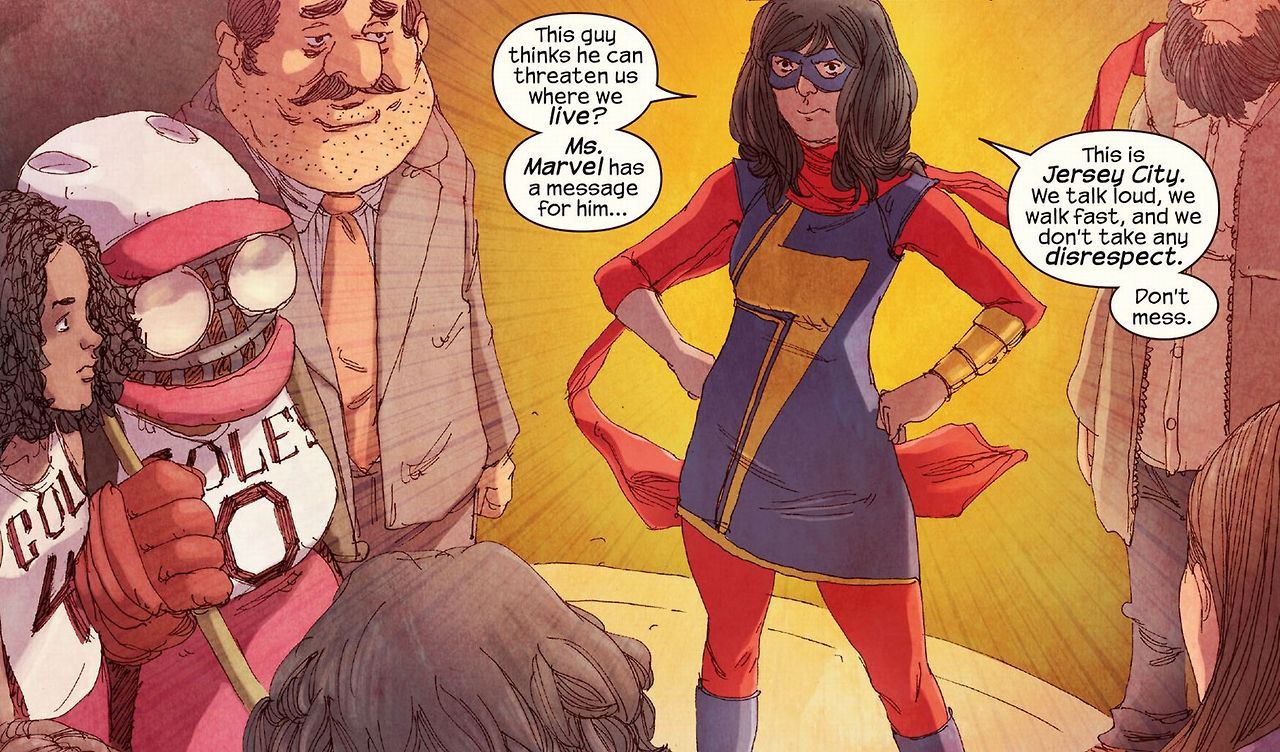Ms. Marvel #5 is the most important comic of the current era. Wait, I got ahead of myself.
Comics have distinct eras that you can recognize simply by flipping through an issue. Whether it's the artwork, subject matter, costume design or the overall presentation, fans can get an idea of when the book came out, and who its intended audience is. It's one of the reasons I have a hard time recommending older first issues to new readers; X-Men #1 is going to seem weird to someone who has never read any X-Men, whether it's due to the silted language and design of the original or the '90s posing and over-lettered pages of the Claremont/Lee version. It can seem really dated for new readers, and can completely color a generation of fans' expectations of what comics should "really be like." This is my only explanation for the extreme Jim Lee-ness of the New 52 costume designs.
With this is mind, trying to peg the overall theme of the current era of comics is still a little tricky. Do we use the movies as an example of how future generations will view the medium? Will Civil War and Identity Crisis, with their adult themes, be how the early 2000s are remembered? Do we have Brian Michael Bendis to thank for the voice of this modern era?
This brings me back to my cause this week: I would like Ms. Marvel #5 to be the bar by which the current era is measured. This comic does so much right, and is so absolutely inspiring, that I want to see followers, imitators and an entire generation of fans who will expect this level of quality in their comics in the days to come. Did I get ahead of myself again? Let me catch you up.
WARNING: I'll be discussing Ms. Marvel #5, so grab your copy (buy three more!) and read along!
For those of you who might have passed this by or have been living under a rock for the past few months, Ms. Marvel is about Kamala Khan, a New Jersey teenager. Due to the "Infinity," event, she's been super-powered by the Terrigen Mists and given shapeshifting abilities. Inspired to do good by her favorite hero, Captain Marvel, she helps friends and fights bad guys but is still looking for direction in her life. There are family hijinks and even some culture shock.
Representations of other cultures and nationalities in mainstream American superhero comics typically have been a little awkward and shallow (see Chris Claremont's fondness for peppering dialogue with expressions like "Unglaublich" or "Begorrah"). Different ethnicities have been so easily, and so regularly, fumbled that we've become accustomed to it. But in Ms. Marvel, the portrayal feels less like culture shock and more like a cultural comparison as Kamala's problems and lifestyle don't exactly revolve around her heritage, but rather who she is and becomes spins off from it. Her family is a lot like mine -- they just have a different motivation. Not fitting in is the root of Kamala's teen woes, but being Muslim is merely a new flower on this common problem. She's inspired not by representation but by success. Nothing is pigeonholed, so everything is relatable to one extent or another. Kamala's problems could be yours.
Ms. Marvel #5 completes Kamala's origin and first story arc. Previously, a friend's brother got caught up in some crimes, and Kamala sets off her to rescue him but, surprisingly, fails. It's a big deal. When people talk about "grit" in their comics, I think they're trying to talk about honesty; it's not the darker coloring and style that makes gritty comics, it's washing off the cartoon gloss with some reality sandpaper to make the story seem more realistic to the reader. The idea that a teenager who just got superpowers can't run in an save a friend from other teenagers in a basement is pretty realistic. Kamala goes home and gets yelled at by her mother, but also receives a pep talk from her father that is some of the most beautiful writing between father and daughter I've read in a long time. This is also a big deal, as pep talks from father figures are a more male hero trope than female; most girls have to go it alone or defy their parents and break from the norm and become someone society doesn't expect them to be. Kamala's father tells her that she's perfect just the way she is and doesn't have to pretend to be someone else to be loved by her family.
That spurs Kamala into a training montage with her best friend to learn about her powers so she can try again. Hard work pays off as she ponders some philosophy to psych herself up for her second try. The idea that good isn't something you are, it's something you do and that the place where you are right now was circled on a map for you (which I think should be attributed to Hāfez rather than Rumi, but I could be wrong) are poetically inspiring to both Kamala and the reader. It's less a selfish motivation (I'm going to be the best) and more a reflection of destiny.
It's a destiny that still takes hard work, but one that pays off, because with a little more grounding and dedication, Kamala not only saves her friend's brother, but gains a confidence we can believe in. We saw her fail, and we were with her as she picked herself up; now, with her success, we know she's capable of whatever she sets her mind to. Is Kamala perfect? Heck no. As she says herself, "This is Jersey City. We talk loud, we walk fast and we don't take any disrespect." She has her faults, but you know. Don't mess. The first five issue complete her first journey, and we readers can see the long road ahead.
This book is important. I want it to be the blueprint for future heroic orgins to work from. I want fans who clamor for realized female characters in comics to hold up this issue and support the work being done here. The artwork is magical; some of the manga-like stylings can take getting used to, but for such an imaginative setting and style I can't see any other artist in Adrian Alphona's place. G. Willow Wilson's writing is so heartfelt, it's difficult not to fall in love with such a unique and personable character as Kamala Khan.
In another decade or so, it would do my heart good to think this is the kind of story that came out of the 2010s and is the standard the era is judged by.



